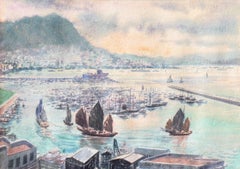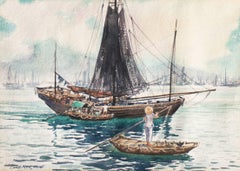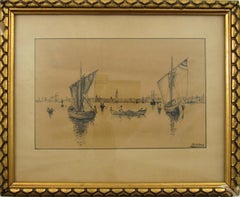George Marzan Art
to
2
2
2
Overall Height
to
Overall Width
to
1
2
1
1
1
1
1
1
1
1
2
2
2
6,898
3,229
2,514
1,217
2
2
2
Artist: George Marzan
'Victoria Peak, Hong Kong'
By George Marzan
Located in Santa Cruz, CA
Signed lower center, 'Geo Marzan' and painted circa 1965.
Panoramic sunset view of Causeway Bay, Hong Kong, with numerous fishing vessels and pleasure boats, and Victoria Peak risin...
Category
1960s Modern George Marzan Art
Materials
Watercolor, Paper
Causeway Bay, Hong Kong
By George Marzan
Located in Santa Cruz, CA
Signed lower left, 'Geo Marzan' and painted circa 1965.
A panoramic sunset view of Causeway Bay, Hong Kong, with a fishing boat and other smaller craft in the foreground and Victori...
Category
1960s George Marzan Art
Materials
Paper, Watercolor
Related Items
Rare Chaim Gross Watercolor Painting Manhattan Skyscrapers Train NYC WPA Artist
By Chaim Gross
Located in Surfside, FL
This appears to be dated 1927. It came in with a piece dated 1929. A very early, rare work.
Framed 22.5 x 18. Image 14.5 x 9
A great New York city street scene with an El train (elevated subway line) and architectural renderings of buildings.
This is a wonderful piece by one of America's most treasured artists, Chaim Gross. Throughout his lifetime Gross has gone through tragedy and a real test of faith however, he has the unique ability to focus and direct his expression to the most joyful and beautiful works of art, such as the present lot. For more than sixty years Chaim Gross's art has expressed optimistic, affirming themes. His acrobats, cyclists, and mothers and children convey joyfulness, exuberance, love, and intimacy. This aspect of his work
remained consistent with his Hasidic heritage, which teaches that "only in his childlike happiness is man nearest to God." He often used his creative abilities to explore and experiment with media. In his artwork he retains an optimistic philosophy, even when facing somber issues such as war, depression, and the Holocaust.
Chaim Gross (March 17, 1904 – May 5, 1991) was an American sculptor and educator.
Gross was born to a Jewish family in Austrian Galicia, in the village of Wolowa (now known as Mezhgorye, Ukraine), in the Carpathian Mountains. In 1911, his family moved to Kolomyia (which was annexed into the Ukrainian USSR in 1939 and became part of newly independent Ukraine in 1991). When World War I ended, Gross and brother Avrom-Leib went to Budapest to join their older siblings Sarah and Pinkas. Gross applied to and was accepted by the art academy in Budapest and studied under the painter Béla Uitz, though within a year a new regime under Miklos Horthy took over and attempted to expel all Jews and foreigners from the country. After being deported from Hungary, Gross began art studies at the Kunstgewerbeschule in Vienna, Austria shortly before immigrating to the United States in 1921. Gross's studies continued in the United States at the Beaux-Arts Institute of Design, where he studied with Elie Nadelman and others, and at the Art Students League of New York, with Robert Laurent. He also attended the Educational Alliance Art School, studying under Abbo Ostrowsky, at the same time as Moses Soyer and Peter Blume.
In 1926 Gross began teaching at The Educational Alliance, and continued teaching there for the next 50 years. Louise Nevelson was among his students at the Alliance (in 1934), during the time she was transitioning from painting to sculpture. In the late 1920s and early 1930s he exhibited at the Salons of America exhibitions at the Anderson Galleries and, beginning in 1928, at the Whitney Studio Club. In 1929, Gross experimented with printmaking, and created an important group of 15 linocuts and lithographs of landscapes, New York City streets and parks, women in interiors, the circus, and vaudeville. The entire suite is now in the collection of the Philadelphia Museum of Art. Gross returned to the medium of printmaking in the 1960s, and produced approximately 200 works in the medium over the next two decades.
In March 1932 Gross had his first solo exhibition at Gallery 144 in New York City. For a short time they represented Gross, as well as his friends Milton Avery, Moses Soyer, Ahron Ben-Shmuel and others.
Gross was primarily a practitioner of the direct carving method, with the majority of his work being carved from wood. Other direct carvers in early 20th-century American art include William Zorach, Jose de Creeft, and Robert Laurent. Works by Chaim Gross can be found in major museums and private collections throughout the United States, with substantial holdings (27 sculptures) at the Hirshhorn Museum and Sculpture Garden. A key work from this era, now at the Smithsonian American Art Museum, is the 1932 birds-eye maple Acrobatic Performers, which is also only one and one quarter inch thick.
In 1933 Gross joined the government's PWAP (Public Works of Art Project), which transitioned into the WPA (Works Progress Administration), which Gross worked for later in the 1930s. Under these programs Gross taught and demonstrated art, made sculptures that were placed in schools and public colleges, made work for Federal buildings including the Federal Trade Commission Building, and for the France Overseas and Finnish Buildings at the 1939 New York World's Fair. Gross was also recognized during these years with a silver medal at the Exposition universelle de 1937 in Paris, and in 1942, with a purchase prize at the Metropolitan Museum of Art's "Artists for Victory" exhibition for his wood sculpture of famed circus performer Lillian Leitzel.
In 1949 Gross sketched Chaim Weizmann, President of Israel, at several functions in New York City where Weizmann was speaking, Gross completed the bust in bronze later that year. Gross returned to Israel for three months in 1951 (the second of many trips there in the postwar years) to paint a series of 40 watercolors of life in various cities. This series was exhibited at the Jewish Museum (Manhattan) in 1953.
In the 1950s Gross began to make more bronze sculptures alongside his wood and stone pieces, and in 1957 and 1959 he traveled to Rome to work with famed bronze foundries including the Nicci foundry. At the end of the decade Gross was working primarily in bronze which allowed him to create open forms, large-scale works and of course, multiple casts. Gross's large-scale bronze The Family, donated to New York City in 1991 in honor of Mayor Ed Koch, and installed at the Bleecker Street Park at 11th street, is now a fixture of Greenwich Village. In 1959, a survey of Gross's sculpture in wood, stone, and bronze was featured in the exhibit Four American Expressionists curated by Lloyd Goodrich at the Whitney Museum of American Art, with work by Abraham Rattner, Doris Caesar, and Karl Knaths. In 1976, a selection from Gross's important collection of historic African sculpture, formed since the late 1930s, was exhibited at the Worcester Art Museum in the show The Sculptor's Eye: The African Art Collection of Mr. and Mrs. Chaim Gross. Gross was elected into the National Academy of Design as an Associate member, and became a full Academician in 1981. In 1984, he was inducted into the American Academy of Arts and Letters, with Jacob Lawrence and Lukas Foss. In the fall of 1991, Allen Ginsberg gave an important tribute to Gross at the American Academy of Arts and Letters, which is published in their Proceedings. In 1994, Forum Gallery, which now represents the Chaim Gross estate, held a memorial exhibition featuring a sixty-year survey of Gross's work.
Gross was a professor of printmaking and sculpture at both the Educational Alliance and the New School for Social Research in New York City, as well as at the Brooklyn Museum Art School, the MoMA art school, the Art Student's League and the New Art School (which Gross ran briefly with Alexander Dobkin...
Category
Mid-20th Century American Modern George Marzan Art
Materials
Paper, Watercolor
Gustav Melcher ( German, 1898 -?) Boats off Venice Italy Ink Water Color c. 1918
By Gustav Melcher
Located in Meinisberg, CH
Gustav Melcher
(German, 1898-?)
Segelschiffe vor Venedig - Sailing ships off Venice
• India ink, water colour wash
• Visible image ca. 11.5 x 18 cm
• Glased Frame ca. 20 x 25 cm
• Verso various inscriptions
• Signed lower right
Gustav Melcher was a German painter and a pioneer in film, film criticism and film theory and created this clever little picture of the skyline of Venice with various vessels.
Going by the various inscriptions an the backing paper, this drawing was made in 1918 when Gustav was twenty years old and passed on three years later to Gertrud Melcher on the 1. 2. 1921. I have no reasons to doubt this information. The small drawing is still in its unopened frame, so maybe there is more information to be discovered , however this will be the privilege of the next owner.
The picture also has retained its original antique frame – note that it has lost over the years various sections of the gesso decoration.
The very precisely executed drawing is most enjoyable to look at and doing so, remember you are looking through the eyes of a young man, who saw this foreign sea cape over a century ago.
Thank you for your interest and please note, that I offer free worldwide shipping on all my items.
Gustav Melcher began his studies at the Düsseldorfer Kunstakademie under Peter Janssen and Eduard von Gebhardt. Originaly he was interested in figurative and portrait painting, but after time he decided to pursue the depiction of land- and marinescapes. Durin his studies the young artist undertook trips to visit England, Scotland, Belgium and France and he joined the artist society Malkasten. It was in those days he would hold speeches to his colleges about this new invention called ‘Kintopp’ – Melcher was a great advocate of the moving pictures...
Category
1910s Naturalistic George Marzan Art
Materials
India Ink, Paper, Watercolor
Gustav MelcherGustav Melcher ( German, 1898 -?) Boats off Venice Italy Ink Water Color c. 1918, 1918
Free Shipping
H 7.88 in W 9.85 in D 0.79 in
Trout stream in Oxfordshire
By John Newberry
Located in Harkstead, GB
A lovely vibrant watercolour capturing a shimmering English river
John Newberry (born 1934)
Stream at Wytham, Oxford
Signed
Watercolour
4¼ x 5¾ inches unframed
9 x 11 inches with fr...
Category
1990s Modern George Marzan Art
Materials
Paper, Watercolor
Dutch landscape with grazing cows near the forest, watercolor, impressionist
By Arnold Marc Gorter
Located in DEVENTER, NL
Watercolor on paper depicting a Dutch landscape (East of The Netherlands) with grazing cows at the edge of a forest, by A. M. Gorter (1866 - 1933).
Dimensions incl. frame: 60 x 72 cm...
Category
Late 19th Century Impressionist George Marzan Art
Materials
Paper, Watercolor
“Rocky Mountain Meadow”
By Werner Drewes
Located in Southampton, NY
Original watercolor on archival paper of a Rocky Mountain Meadow by the well known American artist, Werner Drewes. Signed lower right. Titled and dated 1956 on verso of sheet. Con...
Category
1950s American Modern George Marzan Art
Materials
Watercolor, Archival Paper
Landscape with a Village - Watercolor by Charlotte Jamois - 1939
By Charlotte Jamois
Located in Roma, IT
Landscape with a Village is an original artwork realized in 1939 by Charlotte Jamois in the first half of the 20th century.
Watercolor on paper. Hand-signed by the artist on the low...
Category
1930s Modern George Marzan Art
Materials
Watercolor, Paper
H 8.86 in W 12.21 in D 0.08 in
Original-London St. Pancras-UK Artist-Rare watercolour & ink on collaged paper
Located in London, GB
This Ink and watercolour masterpiece is featured in Bloomsbury's 2011 publication, showcasing the artist's sketchbook (Note 1).
Created en plein air, Shizico Yi painted this piece in...
Category
2010s Contemporary George Marzan Art
Materials
Watercolor, Handmade Paper, Ink
Free Shipping
H 16.93 in W 20.87 in D 0.87 in
Scottish Landscape, possibly Hell's Glen, Argyll Forest Park by Robert Frier
Located in Philadelphia, PA
Robert Frier
(Scottish, 1855–1912)
Scottish Landscape
Watercolor on paper, 11 x 18 3/4 inches (sight)
Framed: 21 x 28 inches (approx.)
Signed at lower left: "Rob Frier"
Inscribed on ...
Category
Late 19th Century Realist George Marzan Art
Materials
Paper, Watercolor
“New England Homestead”
Located in Southampton, NY
Very well executed watercolor on archival paper of a New England homestead nestled in a picturesque valley. Early fall with the tress just starting to change colors. The watercolor was done by the American artist Hilton Leech...
Category
1950s Modern George Marzan Art
Materials
Watercolor, Archival Paper, Graphite
Large Scale Architect's Drawing of a French Mid Century Villa and Garden
Located in Cotignac, FR
A large scale French Mid Century watercolour painting of a stylish late 1950s villa and its garden in the South of France. This painting was acquired with another by the same artist...
Category
Mid-20th Century Modern George Marzan Art
Materials
Paper, Crayon, Watercolor, Gouache
H 26.78 in W 34.26 in D 2.37 in
Modernist Abstract Expressionist Watercolor Painting Bauhaus Weimar Pawel Kontny
By Pawel Kontny
Located in Surfside, FL
Abstract watercolor composition bearing the influence of the earlier color-block compositions of Paul Klee.
Pawel August Kontny, (Polish-German-American artist) He was born in Laurahuette, Poland, in 1923, the son of a wealthy pastry shop owner. In 1939 he began studying architecture in Breslau where he was introduced to the European masters and to the work of some of the German Expressionists, soon afterward banned as "degenerate artists" and removed from museums throughout Germany by the Nazi regime. His studies were interrupted by World War II. Drafted into the German army, traveling in many countries as a soldier, he sketched various landscapes but in 1945, he was captured and held as a prisoner of war in Italy. After the war, he studied at the Union of Nuremberg Architects to help design buildings to replace ones destroyed in the war. He recorded his impressions of the local population and the landscapes through his watercolors and drawings. Pawel Kontny thereafter moved to Nuremberg, Germany, becoming a member of the Union of Nuremberg Architects and helping to rebuild the city's historic center. He soon decided to concentrate on his professional art career. He married Irmgard Laurer, a dancer with the Nuremberg Opera. Pavel Kontny 's career as an artist was launched with his participation in an all German exhibition, held at the Dusseldorf Museum in 1952. He held one-man shows in Germany, Switzerland and the United States. During his trip to the United States in 1960, Kontny became instantly enamored with Colorado, and decided to relocate to Cherry Hills with his wife and two children. He quickly established himself in the local art community, being affiliated for a time with Denver Art Galleries and Saks Galleries. His subject matter became the Southwest. During this time he received the Prestigious Gold Medal of the Art Academy of Rome. His extensive travel provided material for the paintings he did using his hallmark marble dust technique. he also worked equally in pastel, watercolor, charcoal and pencil-and-ink. in a style which merged abstraction and realist styles, influenced by Abstract Expressionist painting and South Western American landscapes. This one bears the influence of Sam Francis. In the early 1960s he was one of only a few European-born professional artists in the state, a select group that included Herbert Bayer (1900-1985), a member of the prewar Bauhaus in Weimar and Dessau, Germany, and Roland Detre (1903-2001), a Hungarian modernist painter. As a Denver, Colorado resident, Pavel Kontny exhibited at galleries and museums throughout the United States, Germany and Japan. There, he was inspired by frequent trips to Native American pueblos in the Southwest, as well as by the study of the Plains Indians of Montana and Wyoming. Over the years Kontny had a number of students and generously helped young artist by hosting exhibitions at his Cherry Hills home. For many years he generously donated his paintings to support charitable causes in Denver. Influences during his European years included German pastelist C.O. Muller, German Informel painter Karl Dahmen and Swiss artist, Hans Erni. In the early 1950s his painting style showed the influence of the Die Brücke (The Bridge), a group of German expressionist artists formed in Dresden in 1905 who had a major impact on the evolution of modern art in the twentieth century in Germany. By the middle of the decade his style incorporated more referential abstraction and total abstraction, resulting in part from his study of Hans Hartung, a German artist based in Paris who exhibited his gestural abstract work in Germany. The American moon landing in 1969 inspired Paul Kontny...
Category
20th Century American Modern George Marzan Art
Materials
Watercolor, Archival Paper
'Fall Fog Approaching'. Contemporary Landscape Clouds Moody sky Blue Green Brown
By Sophia Milligan
Located in Penzance, GB
'Fall Fog, Approaching'. Contemporary landscape painting, Cornwall
Original Artwork, Unframed
_________________
Heavy skies moving in over the autumnal landscape of West Cornwall: a ...
Category
2010s Contemporary George Marzan Art
Materials
Ink, Watercolor, Archival Paper
Free Shipping
H 12 in W 12 in
George Marzan art for sale on 1stDibs.
Find a wide variety of authentic George Marzan art available for sale on 1stDibs. You can also browse by medium to find art by George Marzan in paint, paper, watercolor and more. Much of the original work by this artist or collective was created during the 1960s and is mostly associated with the modern style. Not every interior allows for large George Marzan art, so small editions measuring 15 inches across are available. Customers who are interested in this artist might also find the work of Louis Osman, Albert Richardson, and Tony Broderick. George Marzan art prices can differ depending upon medium, time period and other attributes. On 1stDibs, the price for these items starts at $750 and tops out at $750, while the average work can sell for $750.



